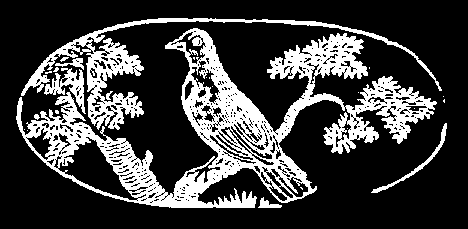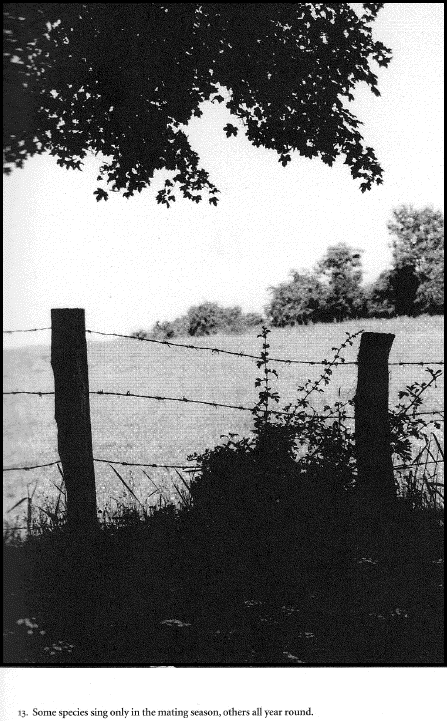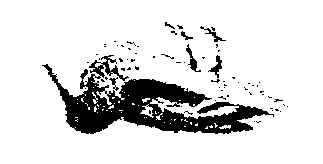The Words of Birds
North America, Britain, and Northern Europe
John Bevis
(MIT)

For a month now he's been pouring out his tiny heart to the forces of love. The only time he lets up is around three in the morning, when the rhythm slows down, becomes more soporific, to me, a tad more comely.
Let's hope he finds a sweetie sooner rather than later. Although he is very persuasive, our neighbor cats have consumed most of his other feathered friends, so I suspect that he is singing to no more than me and the barren 1950 cottages of this blighted area.
When I tried to look up his song in Aaaaw to Zzzzzd (hereinafter referred to A-to-Z) I was buffaloed. The book is not arranged by species, class, or color. It is arranged by song, as if you and I could ever transcribe the song of (for example) the fecund mockingbird.
As best I can understand it, this one is singing, "tseep," but Bevis tells me that is the western flycatcher. "Dzik" which I heard a few moments ago comes from the common yellowthroat, and "kok-ok" (I heard that one too) is the capercaillie, whatever that is. "Gaw gaw gaw" comes solely from the mangrove cuckoo, while "glug-glug-glee" which might be me with my final nightcap --- belongs to the brown-headed cowbird. "Garf garf:" "the lesser scaup." Who? You see what I mean?
As I spend more time with this, I am coming to think that this book with its impossible title is a put-on, cooked up by the sarcastic jokers at MIT. It is a firm little book, seems to be all of a piece, with a typical bird-brain commentary on the wonders of feathered warblers, viz.: "Birdsong has themes, and some birds go in for jazzy variations on their own themes, some are given to baroque flourishes, others to Bach-like inversions and interpretations." (Since I've never heard the Ich habe genug coming out of some tiny beak in my garden, I have my doubts about this one too.)
According to the author, when listening to a nightingale, he thinks, Et in Birdland ego. Is such possible?

A-to-Z is replete with black and white photographs that have nothing whatsoever to do with birds, leading us to further suspicions about its verity. A craggy mountainside is labeled "Each bird may sing differently from time to time." A wretched hut with broken windows is titled "Some species mimic the voices of other species."
A winter tree, not a feather in sight, is marked "In most species only the male sings, in some both male and female sing." A well-kept lawn with a covered well and hedgerow bears the words "There is a wide variety in the purity and character of the notes."
The songs listed here --- and I figure there are over 1,100 of them --- are as cryptic as the birds they are supposed to represent. From a typical page,
-
khreei --- barn owl
ki-aow --- arctic skua
kiaow kiaow --- lesser black-headed gull
kicowk --- coot
kiew kiew --- little owl
kik --- common tern, merlin, middle spotted woodpecker
(One of my favorites of the whole volume is kik kek gep krui tik pit kviu kve tchif tchuf which, we are told, is the simple water rail.)
In the laughter department, there's
- haa-haa-haa-haa --- laughing gull
ha-ha-ha-ha-ha --- yellow-billed loon
ha-ha-ha ha-ha-ha --- willet
hahahahahaha --- common loon.
Whereas the yellow-throated vireo merely says "heh heh heh."
As you may have guessed, I am not too much of a bird person, but I do have a friend who is known for trailing off to such places as the Hebrides, Western Ecuador, or, closer to home, Glaucoma WY or Tutti-Fruitti ME to search for the warblers and meadowlarks and grouses and the woodchat shrike.
She tells me that the most common songbird we have here in the suburbs of California (when the sparrow and turtledoves are not in full throat) is the common linnet. I haven't spied one yet (she says they are very reclusive, hanging out with sparrows rather than respectable feathered folk) but that it has a recognizable song not unlike someone having an intense, chatty conversation with itself --- one that Bevis might transcribe as "bzzt-beedl-zomp-queetle-queetle."
I have been listening to linnets for almost twenty years now in my garden, and I tell you each performance by them is as well-formed a song cycle as "Die Schöne Müllerin." The linnet commences, exactly, with his first phrasing, his tune-up, so to speak, as In your ear.
In your ear. This is bird wisdom, and one not necessarily to be found in A to Z. (Under the "i's," I found but one entry, "if-he if-he if-he" which belongs, according to the author, to the coal tit. A stutterer no doubt.) The linnet, I think, is telling me to shut my mouth and open my ears ... to listen to what he has to say. Which is a Zen-like state of mind that Bevis perhaps could encourage, and should certainly cultivate. If he really exists. If he wasn't created out of the blue by these birdheads at MIT.
Meanwhile, my mockingbird chatters on, and despite what Bevis might presume to think it is, I transcribe it for you exactly below:
- Chortle-chortle-chortle
Cheeky-cheeky
Gleep-gleep-gleep
Dingle-dangle-dingle
Cleep-cleep-cleep-cleep
Bo-leep-bo-leep-bo-leep.
